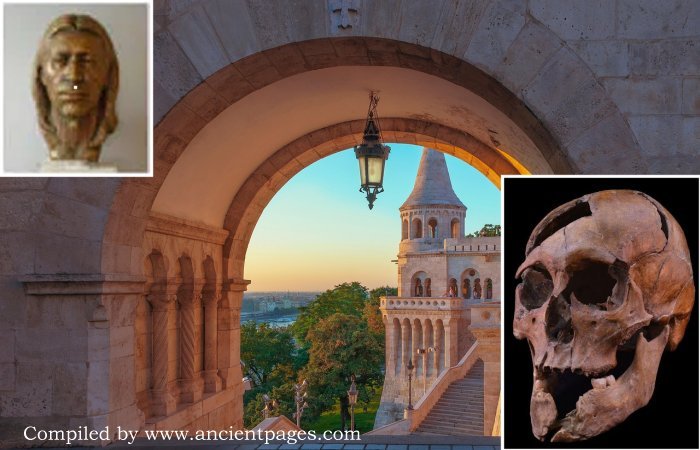Conny Waters – AncientPages.com – The story begins in 1915, when archaeologists excavating the Dominican monastery on Margaret Island in Budapest, Hungary, uncovered the bones of a young man in the sacristy.
Through careful analysis of the burial context, historical records, and signs of trauma on the skeleton, researchers identified these remains as likely belonging to Béla, Duke of Macsó, a notable member of Hungary’s House of Árpád. Béla of Macsó (born after 1243 – died November 1272) was a grandson of King Béla IV through his mother and descended from the Rurik dynasty on his father’s side—a prominent northern European family known for producing many Grand Dukes of Kiev since the 9th century.
Austrian chronicles from the 13th century report that Duke Béla was assassinated in November 1272 by Ban Henrik “Koszegi” from the Héder family and his associates. Contemporary sources describe how his mutilated body was recovered by his sister Margit and niece Erzsébet, who subsequently arranged for his burial at this Dominican monastery.
Lost Bones And A 20th-Century Disappearance
Following the excavation, the remains were sent to Lajos Bartucz at the Institute of Anthropology of Budapest University (now known as the Department of Anthropology, ELTE TTK) for bioanthropological analysis. Bartucz identified 23 sword cuts on the skeleton and several fatal injuries to the skull. His findings indicated that the duke had been attacked by multiple assailants at once and had even sustained blows while lying on the ground. Bartucz first mentioned these bones publicly in 1936 and published a photograph of the skull in 1938.
After this period, references to the remains ceased, leading many experts to believe they were lost during World War II.
The skull of the investigated individual from the 13th century Dominican monastery on Margaret Island, Budapest. Credit: Forensic Science International: Genetics
However, in 2018, researchers unexpectedly rediscovered most of the postcranial bones in a wooden box among thousands of specimens at the Hungarian Museum of Natural History’s Anthropology Collection; meanwhile, curators had continued to preserve the skull within ELTE’s Aurél Török Collection.
Reopening The Case With Modern Science
In 2018, an international research consortium was established under the leadership of Tamás Hajdu from the Department of Biological Anthropology at ELTE TTK. The multidisciplinary team comprised anthropologists, geneticists, an archaeologist, an archaeobotanist, stable isotope specialists, radiocarbon experts, and dentists. Their main goal was to confirm the identity of the remains using advanced forensic and bioarchaeological techniques and to reconstruct as much as possible about the duke’s life and death.
This discovery is of significant historical importance. Apart from King Béla III, Béla of Macsó is the only confirmed member of the House of Árpád whose nearly complete skeleton has been preserved. This offers a rare opportunity to study both the genetic legacy of the Árpád dynasty and its connections to the Rurik line. The project involved researchers from institutions in Vienna, Bologna, Helsinki, Harvard University, as well as several Hungarian organizations.
Biological Profile And Diet Insights
Anthropological analysis determined that the man buried beneath the monastery floor on Margaret Island was in his early twenties. To ensure accuracy, radiocarbon dating was conducted by two separate laboratories after initial 14C measurements indicated a date slightly earlier than expected, placing him in the second half of the 13th century. Further testing at the Nuclear Research Institute in Debrecen revealed that this unexpectedly early date resulted from dietary habits: he had consumed significant amounts of animal protein, including fish and possibly shellfish that fed on ancient carbon sources. This created a known “reservoir effect” in his bones, which can skew radiocarbon results.
To gain deeper insight into his diet, researchers analyzed dental calculus and recovered over a thousand microfossils from his tartar. Starch grains from wheat and barley were identified, along with evidence of milling, cooking, and baking processes. These findings suggest that his diet included cooked wheat semolina and baked wheat bread.
Strontium isotope analysis was also performed to trace where he lived during different stages of life. The results showed that he did not grow up where he was buried; instead, isotope signatures from his early childhood matched those found in Vukovar and Syrmia (now part of Croatia and Serbia), as well as other regions within the Carpathian Basin—areas once part of the Macso Banat in medieval Hungary. Later isotopic evidence suggests he moved during childhood to another area, possibly near present-day Budapest.
Genetic Evidence Links The Skeleton To Royal Lineages
The final identity confirmation was conducted at the Institute of Archaeogenomics of ELTE RCH by Anna Szécsényi-Nagy and Noémi Borbély. Multiple forms of genetic evidence supported the genealogical links outlined in historical records. The findings indicate that Béla of Macsó was the great-grandson (a fourth-degree descendant) of King Béla III, and his genetic distance from Saint Ladislaus aligns with this expected lineage.
Genome-wide analysis showed that Duke Béla had a significant Scandinavian genetic component, accounting for nearly half of his ancestry, alongside notable Eastern Mediterranean heritage and a smaller early medieval Central European element. The strong Scandinavian influence supports his descent from the Rurik dynasty, while the Eastern Mediterranean ancestry likely originates from his maternal grandmother, Maria Laskarina—a member of the Byzantine imperial family and wife to Béla IV. Y-chromosome analysis further confirms the historically documented Rurik paternal line.
Additionally, a 2023 Russian archaeogenomic study found that Dmitry Alexandrovich, a 13th-century member of the Rurikid dynasty, shared this same paternal lineage traceable back to Yaroslav I (Yaroslav Vladimirovich or Yaroslav the Wise). Genetic data from living descendants of the Rurikids further corroborate these connections.
The Brutal Assassination Of Duke Béla Of Macsó
To determine the circumstances of Béla’s death and compare them with medieval records, researchers performed a comprehensive forensic anthropological analysis. Their examination revealed 26 perimortem injuries: nine to the skull and 17 to other parts of the body, all sustained during a single violent incident. The distribution of wounds indicates that three attackers were involved—one facing Béla directly and two striking from his left and right sides.
Genealogy of Duke Béla of Macsó (the facial reconstruction of Béla, Duke of Macsó was made by Ágnes Kustár, while King Béla III’s face was reconstructed by Gyula Skultéty). Credit: Forensic Science International: Genetics
Evidence from the injuries shows that Béla was aware of the assault and attempted to defend himself. The nature of the wounds suggests at least two types of weapons were used, likely a sabre and a longsword. The sharpness and depth of the cuts imply he was not wearing armor at the time.
See also: More Archaeology News
The reconstructed sequence begins with blows to Béla’s head and upper body, followed by defensive injuries as he tried to protect himself. He was eventually incapacitated by side attacks; after he fell, fatal strikes were delivered to his head and face. The severity and number of wounds suggest intense emotional motivation—such as anger or hatred—while their coordinated delivery points toward premeditation. Although Duke Béla’s assassination in November 1272 appears planned in part or whole, forensic evidence indicates it was carried out with considerable violence rather than composure.
The study was published in the journal Forensic Science International: Genetics
Written by Conny Waters – AncientPages.com Staff Writer








